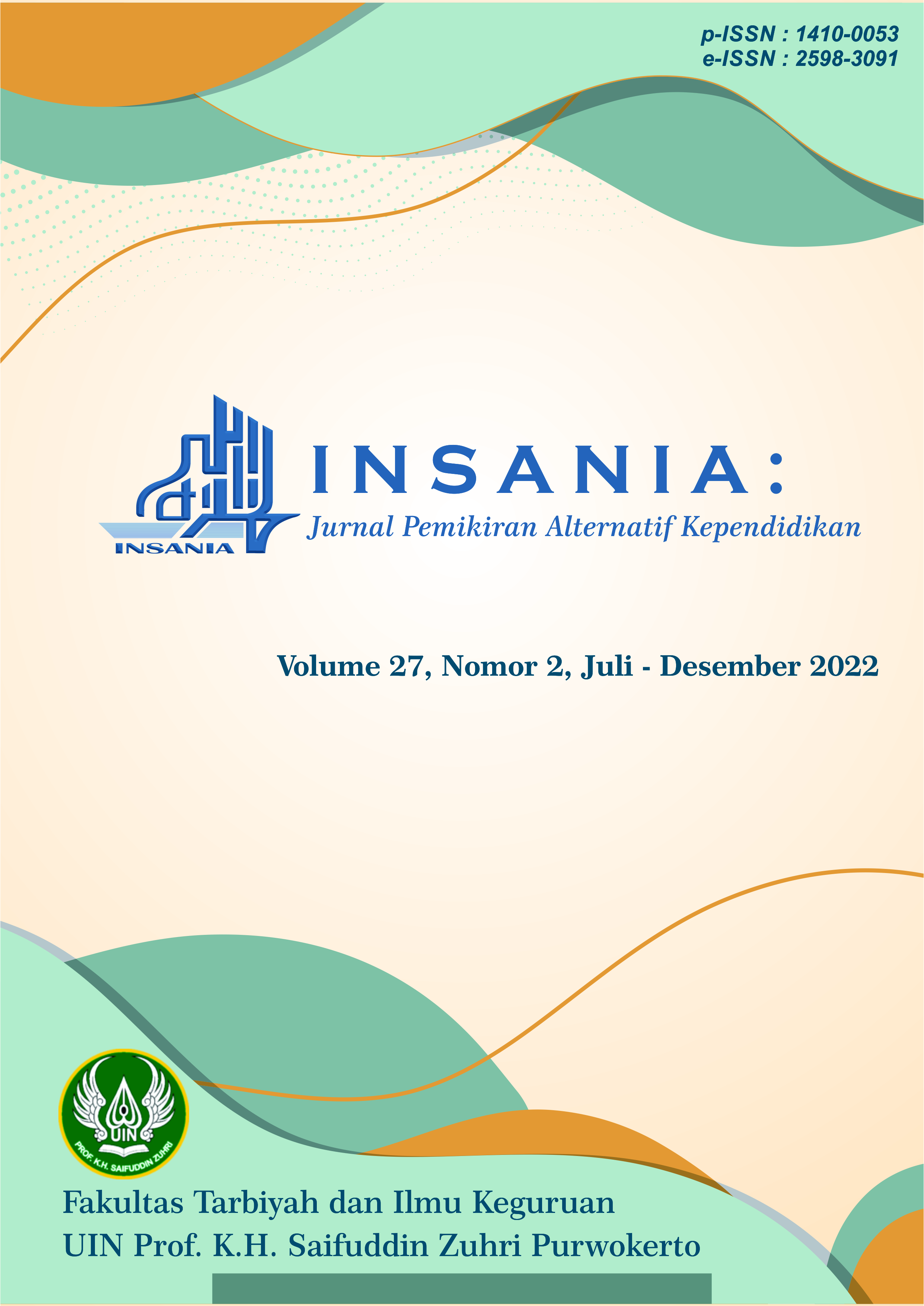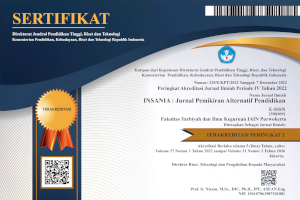The Influence of Applied Educational Statistics Courses on the Competency of Students’ Quantitative Research
DOI:
https://doi.org/10.24090/insania.v27i2.6440Keywords:
statistics education, competency of quantitative researchers, competency of studentAbstract
Quantitative research competence is the main asset for students to be able to carry out quantitative research well and produce quality research results. One of the things that affect the quantitative research competence of a researcher is the mastery of applied statistics. This study aims to determine the effect of Applied Educational Statistics Courses on student competence in quantitative research. For this purpose, the researcher used a survey quantitative research method. The populations of this study were all students of the Madrasah Ibtidaiyah Teacher Education (PGMI) Master Program for the 2021-2022 Universitas Islam Negeri Sunan Kalijaga Yogyakarta who took the Applied Education Statistics course. The sample was taken using the proportional random sampling technique using the Slovin formula, to obtain a total sample of 12 students. Data were collected using a technical questionnaire that had proven its validity and reliability and analyzed by regression analysis. The results of this study indicate that the value of R2 (coefficient of determination) or R Square is 0.259 or 25.9%. This value can be interpreted that changes in student competence in quantitative research by changes in the value of the independent variable in statistics courses are 48, 54 % while 51,46 % is determined by changes in other factors. The calculated value for the Statistics course variable is 2, 203 with sig. 0.052 is smaller than 0.05. This shows that there is an influence of statistics courses on students' quantitative research competence and the factors that influence it.Downloads
References
Agus, I., Sangila, M. S., & Riansyah, F. (2021). Efektifkah perkuliahan daring pada statistika pendidikan di era pandemik covid-19?. Ekspose: Jurnal Penelitian Hukum dan Pendidikan, 20(1), 1174–1181. https://doi.org/10.30863/ekspose.v1i1.1373
Amalia, R. (2020). Analisis Kesalahan Siswa SMP Kelas VIII Pada Pokok Bahasan Statistika. Jurnal Equation: Teori Dan Penelitian Pendidikan Matematika, 3(1), 57–64. http://dx.doi.org/10.29300/equation.v3i1.2644
Anas, S. (2012). Pengantar Statistik Pendidikan. Rajawali Pers.
Arifin, Z., & Retnawati, H. (2017). Pengembangan instrumen pengukur higher order thinking skills matematika siswa SMA kelas X. PYTHAGORAS: Jurnal Matematika dan Pendidikan Matematika, 12(1), 98–108. https://doi.org/10.21831/pg.v12i1.14058
Ashidiqi, M., & Setiawan, W. (2021). Analisis Kesalahan Siswa SMP Mahardika Batujajar Kelas IX E dalam Menyelesaikan Soal Materi Statistika. Jurnal Cendekia: Jurnal Pendidikan Matematika, 5(2), 2010–2019. https://doi.org/10.31004/cendekia.v5i2.705
Atmarita, A., & Syarifuddin, S. (2021). Visual Processing Assessment on Children: A Pilot Study. Jurnal Pendidikan Dan Pembelajaran Indonesia (JPPI), 1(1), 1–9. https://doi.org/10.53299/jppi.v1i1.18
Cahyono, D. A. D. (2021). Penggunaan Aplikasi PowerPoint Sebagai Media Pembelajaran Statistika. Jurnal Dunia Ilmu, 1(2). https://doi.org/10.33365/ji-mr.v3i1.1761
Creswell, J. W. (2009). Research designs: Qualitative, quantitative, and mixed methods approaches. Sage.
Degeng, I. N. S., & Darmawan, I. P. A. (2017). Peningkatan Profesionalisme Pendidik Melalui Penelitian dan Penulisan Karya Ilmiah. Prosiding Seminar Nasional Pendidikan Agama Kristen, II(1), 1 –8. https://semnas.sttsimpson.ac.id/index.php/SNPK/article/view/16
Dzakwan, N., Murtinugraha, R. E., & Arthur, R. (2021). Efektivitas Penggunaan E-Modul Pada Mata Kuliah Statistika Di Program Studi Pendidikan Teknik Bangunan Fakultas Teknik Universitas Negeri Jakarta. Risenologi, 6(1b), 70–77. https://doi.org/10.47028/j.risenologi.2021.61b.249
Fitriyah, Z., Irsalina, S., & Widodo, E. (2021). Analisis Faktor Yang Berpengaruh Terhadap IPM Menggunakan Regresi Linear Berganda. Jurnal Lebesgue: Jurnal Ilmiah Pendidikan Matematika, Matematika Dan Statistika, 2(3), 282–291. https://doi.org/10.46306/lb.v2i3.86
Ghozali, I. (2016). Desain Penelitian Kuantitatif & Kualitatif untuk Akuntansi, Bisnis, dan Ilmu Sosial Lainnya. Yoga Pratama.
Gray, J. S., Brown, M. A., & Connolly, J. P. (2017). Examining Construct Validity of the Quantitative Literacy VALUE Rubric in College-Level STEM Assignments. Research & Practice in Assessment, 12, 20–31. https://eric.ed.gov/?id=EJ1149590
Hardani, H., Andriani, H., Fardani, R. A., Ustiawaty, J., Utami, E. F., Sukmana, D. J., & Istiqomah, R. R. (2020). Metode penelitian kualitatif & kuantitatif. Pustaka Ilmu.
Hartawan, I. G. N. Y., & Suryawan, I. P. P. (2022). Implementasi Bahan Ajar Berbasis Masalah Kontekstual Berbantuan Software Statistika Dalam Meningkatkan Hasil Belajar. Jurnal Pendidikan Matematika Undiksha, 13(1), 74–80. https://doi.org/10.23887/jjpm.v13i1.47073
Irianto, A. (2010). Statistik Konsep Dasar, Aplikasi Pengembangannya. Prenada Media Group.
Irianto, H. A. (2019). Statistik: Konsep Dasar; Aplikasi, dan Pengembangannya. Prenada Media Group.
Irsyad, T., Wuryandini, E., Yunus, M., & Hadi, D. P. (2020). Analisis Keaktifan Mahasiswa dalam Proses Pembelajaran Statistika Mulitvariat. Jurnal Pendidikan Ekonomi Undiksha, 12(1), 89–96. https://doi.org/10.23887/jjpe.v12i1.24294
Jatisunda, M. G., Nahdi, D. S., & Suciawati, V. (2020). Literasi Statistika Mahasiswa Adminitrasi Publik. SJME: Supremum Journal of Mathematics Education, 4(2), 134–146. https://doi.org/10.35706/sjme.v4i2.3488
Mallette, L. A., & Saldaña, J. (2019). Teaching qualitative data analysis through gaming. Qualitative Inquiry, 25(9–10), 1085–1090. https://doi.org/10.1177/1077800418789458
Martias, L. D. (2021). Statistika deskriptif sebagai kumpulan informasi. Fihris: Jurnal Ilmu Perpustakaan dan Informasi, 16(1), 40–59. https://doi.org/10.31004/basicedu.v5i1.632
Martono, N. (2010). Metode penelitian kuantitatif: Analisis Isi dan Analisis Data Sekunder. Raja Grafindo Persada.
Mawoli, M. A., & Babandako, A. Y. (2011). An evaluation of staff motivation, dissatisfaction and job performance in an academic setting. Australian Journal of Business and Management Research, 1(9), 1–13. https://doi.org/10.52283/nswrca.ajbmr.20110109a01
Mbagho, H. M., & Tupen, S. N. (2020). Pembelajaran Matematika Realistik dalam Meningkatkan Hasil Belajar Matematika Materi Operasi Bilangan Pecahan. Jurnal Basicedu, 5(1), 121–132. https://doi.org/10.31004/basicedu.v5i1.632
Maclaren, C., Doyle, K. A., & DiGiuseppe, R. (2016). Rational Emotive Behavior Therapy (REBT) Theory and Practice. In H. E. A. Tinsley, S. H. Lease, & N. S. G. Wiersma (Eds.,), Contemporary Theory and Practice in Counseling and Psychotherapy (pp. 233-263). Sage Publications.
Moore, K. L., Agur, A. M. R., & Dalley, A. F. (2014). Clinically Oriented Anatomy. Lippincott Williams & Wilkins.
Mustofa, M. I., Chodzirin, M., Sayekti, L., & Fauzan, R. (2019). Formulasi model perkuliahan daring sebagai upaya menekan disparitas kualitas perguruan tinggi. Walisongo Journal of Information Technology, 1(2), 151–160. https://doi.org/10.21580/wjit.2019.1.2.4067
Nikiforidou, Z., Lekka, A., & Pange, J. (2010). Statistical literacy at university level: the current trends. Procedia-Social and Behavioral Sciences, 9, 795–799. https://doi.org/10.1016/j.sbspro.2010.12.236
Nurhusain, M., & Hadi, A. (2021). Desain Pembelajaran Statistika Terapan Berbasis Kasus Berkualitas Baik (Valid, Praktis, dan Efektif) untuk Mahasiswa Pendidikan Matematika. Indonesian Journal of Educational Science (IJES), 3(2), 105–119. https://doi.org/10.31605/ijes.v3i2.951
Nursoleha, A., Hartono, H., & Rahmawati, N. F. (2021). Pengaruh store atmosphere terhadap impulse buying melalui hedonic shopping value PT. Trans Retail Indonesia (Transmart Carefour) di Jakarta. JAMBIS: Jurnal Administrasi Bisnis, 1(2), 98–102. https://doi.org/10.31334/jambis.v1i2.1476.g764
Prahesti, V. D. (2019). Implementasi Metode Drill dalam Pembelajaran Matematika Kelas V Sekolah Dasar Islam Bayanul Azhar Tulungagung [Undergraduate Thesis, Universitas Islam Negeri Sayyid Ali Rahmatullah Tulungagung]. UIN SATU Tulungagung Institutional Repository. http://repo.uinsatu.ac.id/10822/
Purwanto, A., Asbari, M., & Santoso, T. I. (2020). Analisis Data Penelitian Manajemen Pendidikan: Perbandingan Hasil antara Amos, SmartPLS, WarpPLS, dan SPSS Untuk Jumlah Sampel Kecil. International Journal Of Social, Policy And Law, 1(1), 111–121. https://doi.org/10.8888/ijospl.v1i1.64
Putri, N. W. S., Wardika, I. W. G. W. G., & Suryati, K. (2022). Efektivitas Pembelajaran secara Hybrid pada Mata Kuliah Statistika. Jurnal Riset Teknologi Dan Inovasi Pendidikan (Jartika), 5(2), 123–138. https://doi.org/10.55122/mediastima.v28i1.385
Ramadani, F. W. (2021). Analisis Kemampuan Statistika Mahasiswa Non Program Studi Pendidikan Matematika di IAIN Bengkulu Tahun 2020 [Undergraduate Thesis, Institut Agama Islam Bengkulu]. E-Repository IAIN Bengkulu. http://repository.iainbengkulu.ac.id/6682/
Rizki, L. M., & Fauziddin, M. (2021). Studi Kasus pada Mahasiswa yang Mengalami Kesulitan Belajar Matakuliah Statistika. Jurnal Pendidikan Tambusai, 5(3), 11304–11314. https://jptam.org/index.php/jptam/article/view/3010
Sakina, N., Nurmawati, S., Sarawati, Y., & Walid, A. (2021). Evaluasi Pembelajaran Daring Terhadap Mata Kuliah Statistika IPA IAIN Bengkulu. Academy of Education Journal, 12(1), 149–157. https://doi.org/10.47200/aoej.v12i1.436
Saputri, N. V. C., Surbakti, D. K. B., Tarmizi, A. D., Supriatno, B., & Anggraeni, S. (2022). Desain Eksperimen Fotosintesis Pengaruh Suhu Bermuatan Literasi Kuantitatif. Jurnal Basicedu, 6(4), 7608–7618. https://doi.org/10.31004/basicedu.v6i4.3482
Sintema, E. J. (2020). Effect of COVID-19 on the performance of grade 12 students: Implications for STEM education. Eurasia Journal of Mathematics, Science and Technology Education, 16(7), 1–6. https://doi.org/10.29333/ejmste/7893
Subijanto, S. (2014). Kompetensi Peneliti untuk Mendukung Penelitian Kebijakan. Jurnal Pendidikan dan Kebudayaan, 20(3), 368–379. https://doi.org/10.24832/jpnk.v20i3.151
Sukardi. (2003). Metodologi Penelitian Pendidikan : Kompetensi Dan Praktiknya. Bumi Aksara
Sudjana, N. (2009). Media Pembelajaran. Sinar Baru Algesindo.
Sudjana, N. (2000). Dasar-dasar Proses Belajar Mengajar. Sinar Baru Algesindo.
Sugiyono, D. (2013). Metode penelitian pendidikan pendekatan kuantitatif, kualitatif dan R&D. Alfabeta.
Syarifuddin, S. (2021). Generalisasi dalam penalaran kuantitatif siswa melalui pemecahan masalah pecahan. AKSIOMA: Jurnal Program Studi Pendidikan Matematika, 10(2), 659–669. https://doi.org/10.24127/ajpm.v10i2.3255
Ulfa, R. (2021). Variabel Penelitian Dalam Penelitian Pendidikan. Al-Fathonah: Jurnal Pendidikan dan Keislaman, 1(1), 342–351. https://jurnal.stitbb.ac.id/index.php/al-fathonah/article/view/44
Wahab, A., Syahid, A., & Junaedi, J. (2021). Penyajian Data Dalam Tabel Distribusi Frekuensi Dan Aplikasinya Pada Ilmu Pendidikan. Education and Learning Journal, 2(1), 40–48. https://doi.org/10.33096/eljour.v2i1.91
Weber, M. A., Schiffrin, E. L., White, W. B., Mann, S., Lindholm, L. H., Kenerson, J. G., Flack, J. M., Carter, B. L., Materson, B. J., Ram, C. V., Cohen, D. L., Cadet, J. C., Jean-Charles, R. R., Taler, S., Kountz, D., Townsend, R. R., Chalmers, J., Ramirez, A. J., Bakris, G. L., Wang, J., … Harrap, S. B. (2014). Clinical practice guidelines for the management of hypertension in the community: a statement by the American Society of Hypertension and the International Society of Hypertension. Journal of clinical hypertension (Greenwich, Conn.), 16(1), 14–26. https://doi.org/10.1111/jch.12237
Walliman, N. (2010). Research methods: The basics. Routledge.
Walliman, N. (2011). Your research project: Designing and planning your work. Sage Publications.
Watson, G. R., & Sottile, J. (2010). Cheating in the digital age: Do students cheat more in online courses?. Online Journal of Distance Learning Administration, 13(1), 1–14. https://eric.ed.gov/?id=EJ877536
Widayanti, W. (2021). Online Learning Media on Science Learning during the COVID-19 Pandemic: A Literature Study in Indonesia. Online Learning in Educational Research, 1(1), 55–61. https://doi.org/10.58524/oler.v1i1.16
Yam, J. H., & Taufik, R. (2021). Hipotesis Penelitian Kuantitatif. Jurnal Ilmu Administrasi, 3(2), 96–102. https://doi.org/10.33592/perspektif.v3i2.1540
Yosmar, S., Afandi, N., & Swita, B. (2019). Kajian kemampuan literasi kuantitatif siswa sma 8 kota bengkulu. Jurnal Pengabdi, 2(1), 137–146. http://dx.doi.org/10.26418/jplp2km.v2i1.31487
Yuliana, L., Sugiyono, S., & Mehta, K. (2020). A Comparative study in character education management models in Indonesia and India. Harmoni Sosial: Jurnal Pendidikan IPS, 7(2), 170–182. https://doi.org/10.21831/hsjpi.v7i2.37143
Zulfikri, Z. (2017). Pengaruh Mata Kuliah Statistik Terhadap Kemampuan Analisa Data Kuantitatif Mahasiswa Prodi S-1 Ilmu Perpustakaan Angkatan 2011-2012 Fakultas Adab dan Humaniora UIN Ar-Raniry. Libria, 8(1). https://doi.org/10.22373/1229
Zulnaidi, H., & Zamri, S. N. A. S. (2017). The effectiveness of the GeoGebra software: The intermediary role of procedural knowledge on students’ conceptual knowledge and their achievement in mathematics. Eurasia Journal of Mathematics, Science and Technology Education, 13(6), 2155–2180. https://doi.org/10.12973/eurasia.2017.01219a
Downloads
Published
How to Cite
Issue
Section
License
Copyright (c) 2022 Vivin Devi Prahesti, Shaleh Shaleh

This work is licensed under a Creative Commons Attribution-ShareAlike 4.0 International License.
Authors who publish with this journal agree to the following terms:
Authors retain copyright and grant the journal right of first publication with the work simultaneously licensed under a Creative CommonsAttribution-ShareAlike License that allows others to share the work with an acknowledgment of the work's authorship and initial publication in this journal.
Authors are able to enter into separate, additional contractual arrangements for the non-exclusive distribution of the journal's published version of the work (e.g., post it to an institutional repository or publish it in a book), with an acknowledgment of its initial publication in this journal.
Authors are permitted and encouraged to post their work online (e.g., in institutional repositories or on their website) prior to and during the submission process, as it can lead to productive exchanges, as well as earlier and greater citation of published work (See The Effect of Open Access).









